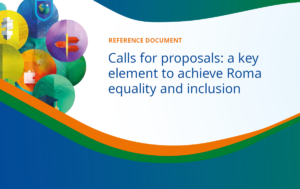This reference document aims to gather, based on partners’ experience and reflections within the Network, aspects to be considered by relevant authorities in the design and launch of the calls for proposals of the 2021-2027 programming period to ensure that they set the adequate basis for future interventions to contribute to Roma equality and inclusion and to adopt the approaches with the highest potential to achieve social change.
 EURoma releases this reference document with the aim to reference document with the aim to gather, based on partners’ experience and reflections within the Network, aspects to be considered by relevant authorities in the design and launch of the calls for proposals of the 2021-2027 programming period to ensure that they set the adequate basis for future interventions to contribute to Roma equality and inclusion and to adopt the approaches with the highest potential to achieve social change.
EURoma releases this reference document with the aim to reference document with the aim to gather, based on partners’ experience and reflections within the Network, aspects to be considered by relevant authorities in the design and launch of the calls for proposals of the 2021-2027 programming period to ensure that they set the adequate basis for future interventions to contribute to Roma equality and inclusion and to adopt the approaches with the highest potential to achieve social change.
We observe a positive picture as regards the consideration of Roma equality and inclusion in the programming documents of the 2021-2027 European Cohesion Policy Funds (to which EURoma contributed with the publication of the “EURoma Checklist for the Effective Inclusion of Roma Interventions within European Cohesion Policy Funds programming 2021-2027”). A large number of countries plan to devote resources to support Roma equality and inclusion, using different options in terms of funds (ESF+, ERDF or others), scope (national/regional level), approaches (target, mainstream or territorial), Specific Objectives, intervention fields…
Now it is time to focus on the actual translation of these programming documents into practice to prevent, as it happened in previous programming periods, a gap between the programming and the implementation. In many cases, even when the programming documents adopted set a favourable framework for promoting Roma equality and inclusion, the results and impact on the ground did not necessarily correspond. This was mainly related to the different elements set for the implementation, among them the calls for proposals, which seem to be the most commonly used mechanism for the allocation of funds.
Calls for proposals have proved to the be one of the determining elements for the success in the implementation. On the one hand, they serve to translate what is established in the programming documents into practice. On the other, the way the calls are designed and planned determine to a great extent the characteristics of the projects/interventions that will be selected and implemented as well as their potential efficiency, effectiveness and impact.
EURoma Reference Document outlines a number of aspects to be considered, including:
- Duration/timeframe
- Scale
- Actors involved
- Scope of projects/ interventions
- Integrated and comprehensive approach
- Ensuring that the calls contribute to Roma equality and inclusion, whether they are planned under the “Roma-related Specific Objectives” or others
- Simplification of administrative aspects

